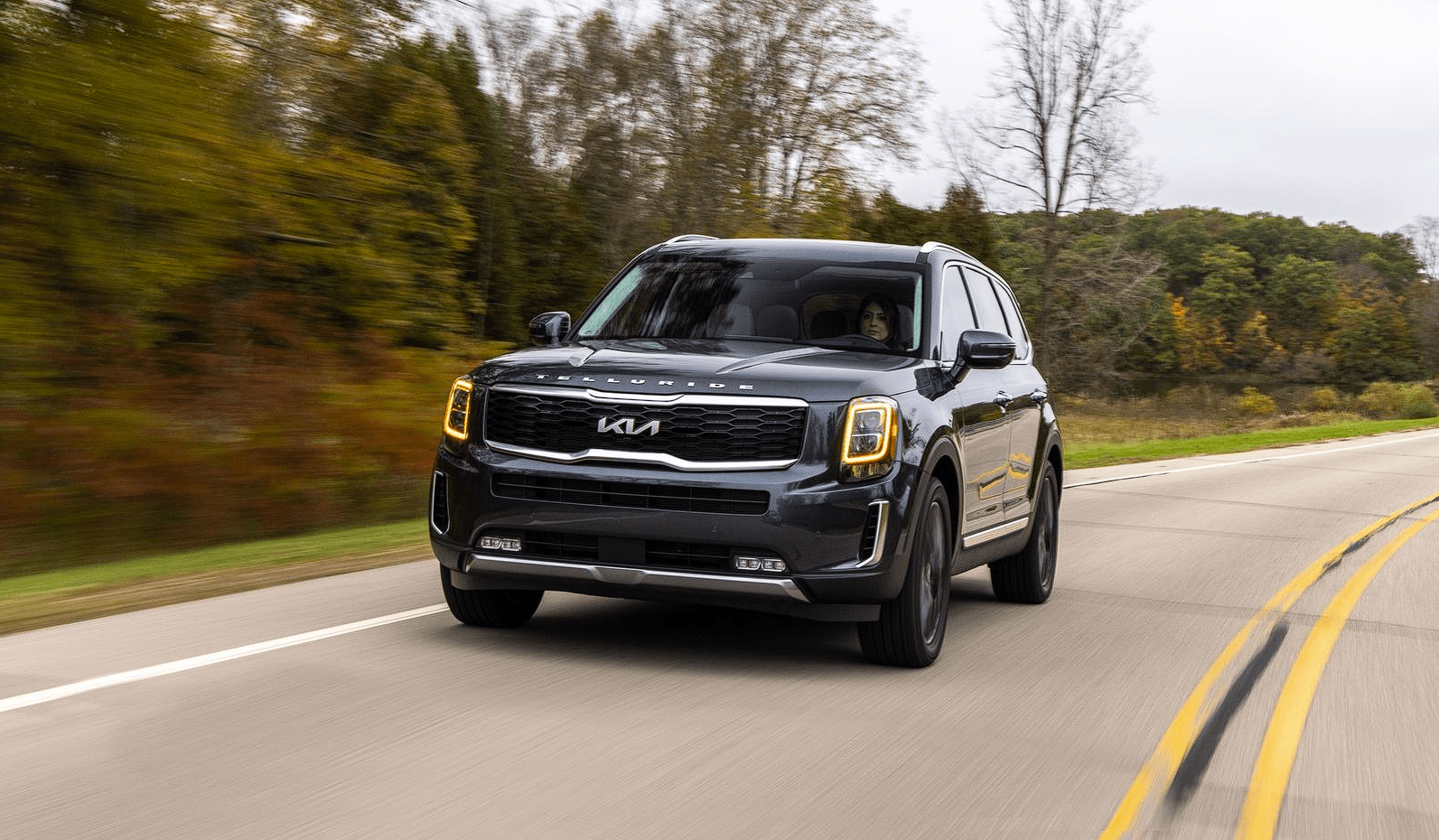Kia Telluride 2022 Important Safety Precautions and Seat
As safety standards for cars are always changing, the 2022 Kia Telluride is a shining example of how to keep passengers safe. This shows how important Safety Precautions and Seat Belts are for modern driving. This midsize SUV is a great example of Kia’s approach to safety because it protects both drivers and passengers. Its carefully thought-out Safety Precautions include a wide range of high-tech features, such as a strong airbag system and the latest driver-aid technologies, all of which are meant to lower risks and make driving safer. Seat Belts are at the heart of this safety story. They combine form and function in a choreographed dance of restraint and protection that keeps people safely wrapped up in the vehicle’s protective hug. Within this in-depth analysis, we explore the complicated world of the 2022 Kia Telluride’s Safety Precautions and Seat Belts, revealing their many functions, cutting-edge technologies, and unwavering dedication to making every journey a safe and secure one in this exceptional midsize SUV.
2023 Kia Telluride Specs, Price, Features and Mileage (Brochure)
Important Safety Precautions
You will find many safety precautions and recommendations throughout this section, and throughout this manual. The safety precautions in this section are among the most important.
Always Wear Your Seat Belt
A seat belt is your best protection in all types of accidents. Airbags are designed to supplement seat belts, not replace them. So even though your vehicle is equipped with air bags, ALWAYS make sure you and your passengers wear your seat belts, and wear them properly.
Restrain All Children
All children under age 13 should ride in your vehicle properly restrained in the rear seat, not the front seat. Infants and small children should be restrained in an appropriate child restraint. Larger children should use a booster seat with the lap/shoulder belt until they can use the seat belt properly without a booster seat.
Air Bag Hazards
While air bags can save lives, they can also cause serious or fatal injuries to occupants who sit too close to them, or who are not properly restrained. Infants, young children, and shorter adults are at the greatest risk of being injured by an inflating airbag. Follow all instructions and warnings in this manual.
Driver Distraction
Driver distraction presents a serious and potentially deadly danger, especially for inexperienced drivers. Safety should be the first concern when behind the wheel and drivers need to be aware of the wide array of potential distractions, such as drowsiness, reaching for objects, eating, personal grooming, other passengers, and using cellular phones.
Drivers can become distracted when they take their eyes and attention off the road or their hands off the wheel to focus on activities other than driving. To reduce your risk of distraction or getting into an accident:
- ALWAYS set up your mobile devices (i.e., MP3 players, phones, navigation units, etc.) when your vehicle is parked or safely stopped.
- ONLY use your mobile device when allowed by laws and when conditions permit safe use. NEVER text or email while driving. Most states have laws prohibiting drivers from texting. Some states and cities also prohibit drivers from using handheld phones.
- NEVER let the use of a mobile device distract you from driving. You have a responsibility to your passengers and others on the road to always drive safely, with your hands on the wheel as well as your eyes and attention on the road.
Control Your Speed
Excessive speed is a major factor in crash injuries and deaths. Generally, the higher the speed, the greater the risk, but serious injuries can also occur at lower speeds. Never drive faster than is safe for current conditions, regardless of the maximum speed posted.
Seat Belts
Seat belts are designed to bear upon the bony structure of the body, and should be worn low across the front of the pelvis, chest and shoulders.
Seat belt restraint system
For maximum restraint system protection, the seat belts must always be used whenever the vehicle is moving.
- A properly positioned shoulder belt should be positioned midway over your shoulder across your collarbone.
- Never allow children to ride in the front passenger seat.
WARNING
Twisted seat belt
Make sure your seat belt is not twisted when worn. A twisted seat belt may not properly protect you in an accident and could even cut into your body.
WARNING
Shoulder Belt
- Never wear the shoulder belt under your arm or behind your back. An improperly positioned shoulder belt cannot protect the occupant in a crash.
- Always wear both the shoulder portion and lap portion of the lap/shoulder belt.
WARNING
Damaged seat belt
Any damage in webbing or hardware may lead to serious injury or death in a crash. For your safety, replace the entire seat belt assembly when any part of the webbing or hardware is damaged.
Seat belts are designed to bear upon the bony structure of the body, and should be worn low across the front of the pelvis, chest and shoulders, as applicable; wearing the lap section of the belt across the abdominal area must be avoided.
Seat belts should be adjusted as firmly as possible, consistent with comfort, to provide the protection for which they have been designed.
A slack belt will greatly reduce the protection afforded to the wearer.
Care should be taken to avoid contamination of the webbing with polishes, oils, and chemicals, particularly battery acid. Cleaning may safely be carried out using mild soap and water. The belt should be replaced if the webbing becomes frayed, contaminated or damaged.
- No modifications or additions should be made by the user which would either prevent the seat belt adjusting devices from operating to remove slack or prevent the seat belt assembly from being adjusted to remove slack.
- When you fasten the seat belt, be careful not to latch the seat belt in the buckles of other seats. It is very dangerous and you may not be protected by the seat belt properly.
- Do not unfasten the seat belt and do not fasten and unfasten the seat belt repeatedly while driving. This could result in loss of control, and an accident causing death, serious injury, or property damage.
- When fastening the seat belt, make sure that the seat belt does not pass over objects that are hard or can break easily.
WARNING
Seat belt buckle
Do not allow foreign material (gum, crumbs, coins, liquids, etc.) to obstruct the seat belt buckle. This may prevent the seat belt from fastening securely.
Driver’s seat belt warning
As a reminder to the driver, the driver’s seat belt warning lights will illuminate for approximately 6 seconds each time you turn the ENGINE START/STOP button ON regardless of belt fastening. If the seatbelt is not fastened, the warning chime will sound for about 6 seconds.
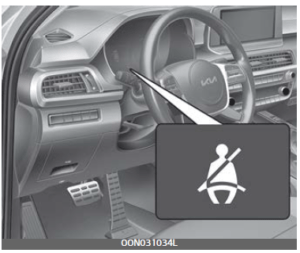
If you start to drive without the seat belt fastened or you unfasten the seat belt when you drive over 5 mph (9 km/h) and less than 12 mph (20 km/h), the corresponding warning light will illuminate. The warning light will turn off when the vehicle’s speed drops below 5 mph (9 km/h).
If you start to drive without the seat belt fastened or you unfasten the seat belt when you drive 12 mph (20 km/h) and faster, the warning light will blink and a warning chime will sound for approximately 100 seconds. When the seat belt is unfastened during driving, the warning light will illuminate when the speed is under 12 mph (20 km/h). When the speed is 12 mph (20 km/h) and faster, the warning light will blink and a warning chime will sound for approximately 100 seconds.
Front passenger’s seat belt warning
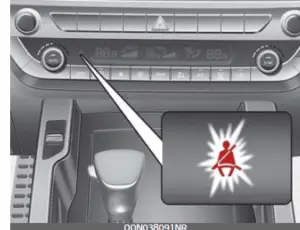
As a reminder to the front passenger, the front passenger’s seat belt warning lights will illuminate for approximately 6 seconds each time you turn the ENGINE START/STOP button ON regardless of belt fastening. If you start to drive without the passenger seat belt fastened or the passenger unfastens the seat belt when you drive over 5 mph (9 km/h) and less than 12 mph (20 km/h), the corresponding warning light will illuminate. The warning light will turn off when the vehicle speed drops below 5 mph (9 km/h).
If you start to drive without the passenger seat belt fastened or you unfasten the seat belt when you drive 12 mph (20 km/h) and faster, the warning light will blink and warning chime will sound for approximately 100 seconds. When the passenger seat belt is unfastened during driving, the warning light will illuminate when the speed is under 12 mph (20 km/h). When the speed is 12 mph (20 km/h) and faster, the warning light will blink and a warning chime will sound for approximately 100 seconds.
NOTICE
- Even if the front passenger seat is not occupied, the seat belt warning light will illuminate for 6 seconds.
- The front passenger’s seat belt warning may operate when lug gage is placed on the front passenger seat.
Seat belt – Driver’s 3-point system with emergency locking retractor
The following explains how to fasten and adjust the driver’s seat belt.
Fastening the your seat belt:
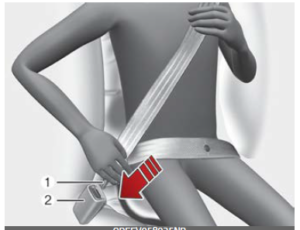
- Pull it out of the retractor and insert the metal tab (1) into the buckle (2).
There will be an audible “click” when the tab locks into the buckle.
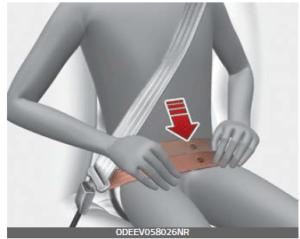
WARNING
You should place the lap belt portion as low as possible and snugly across your hips. If the lap belt is located too high on your waist, it may increase the chance of injury in the event of a collision.
The arm closest to the seat belt buckle should be over the belt while the other arm should be under the belt as shown in the illustration. Never wear the seat belt under the arm closest to the door.
The seat belt automatically adjusts to the proper length only after the lap belt portion is adjusted manually so that it fits snugly around your hips. If you lean forward in a slow, easy motion, the belt will extend and let you move around. If there is a sudden stop or impact, however, the belt will lock into position. It will also lock if you try to lean forward too quickly.
NOTICE
If you are not able to pull out the seat belt from the retractor, firmly pull the belt out and release it. Then you will be able to pull the belt out smoothly.
Adjusting the height of the shoulder belt
You can adjust the height of the shoulder belt anchor to one of the 4 positions for maximum comfort and safety.
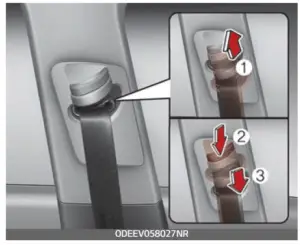
The height of the adjusting seat belt should not be too close to your neck. The shoulder portion should be adjusted so that it lies across your chest and midway over your shoulder near the door and not your neck.
To adjust the height of the seat belt anchor, lower or raise the height adjuster into an appropriate position.
- To raise the height adjuster, pull it up (1).
- To lower it, push it down (3) while pressing the height adjuster button (2).
Release the button to lock the anchor into position. Try sliding the height adjuster to make sure that it has locked into position.
Improperly positioned seat belts can cause serious injuries in an accident.
WARNING
Shoulder belt positioning
Verify the shoulder belt anchor is locked into position at the appropriate height. Never position the shoulder belt across your neck or face. Improperly positioned seat belts can cause serious injuries in an accident.
WARNING
Seat belt replacement
Replace your seat belts after being in an accident. Failure to replace seat belts after an accident could leave you with damaged seat belts that will not provide protection in the event of another collision.
Seat belts – Front passenger and rear seat 3-point system with combination locking retractor
The following explains how to fasten the passenger’s and rear seat belt.
Fastening your seat belt:
Combination retractor-type seat belts are installed in the rear seat positions to help accommodate the installation of Child Restraint System. Although a combination retractor is also installed in the front passenger seat position, it is strongly recommended that children always be seated in the rear seat. NEVER place any infant restraint system in the front seat of the vehicle.
This type of seat belt combines the features of both an emergency locking retractor seat belt and an automatic locking retractor seat belt.
- Pull it out of the retractor and insert the metal tab into the buckle. There will be an audible “click” when the tab locks into the buckle. When not securing a child restraint, the seat belt operates in the same way as the driver’s seat belt (emergency locking retractor type).
It automatically adjusts to the proper length only after the lap belt portion of the seat belt is adjusted manually so that it fits snugly around your hips.
When the seat belt is fully extended from the retractor to allow the installation of a Child Restraint System, the seat belt operation changes to allow the belt to retract, but not to extend (automatic locking retractor type).
NOTICE
Although the combination retractor provides the same level of protection for seated passengers in either emergency or automatic locking modes, have the seated passengers use the emergency locking feature for improved convenience. The automatic locking function is intended to facilitate child restraint installation. To convert from the automatic locking feature to the emergency locking operation mode, allow the unbuckled seat belt to fully retract.
CAUTION
Do NOT fold down the left portion of the rear seatback when the rear centre seat belt is buckled. ALWAYS UNBUCKLE the rear center seat belt before folding down the left portion of the rear seatback. If the rear centre seat belt is buckled when the left portion of the rear seatback is folded down, distortion and damage to the top portion of the seatback and seat belt garnish may result, causing the seatback to lock into the folded down position.
The seat belt should be locked into the buckle on each seat cushion to be properly fastened.
2nd row seat

- Rear right seat belt fastening buckle
- Rear center seat belt fastening buckle
- Rear left seat belt fastening buckle
WARNING
Prior to fastening the rear seat belts, ensure the latch matches the seat belt buckle. Forcefully fastening the left or right seat belt to the center buckle can result in an improper fastening scenario that will not protect you in an accident.
When using the rear center seat belt, the buckle with the “CENTER” mark must be used.
2nd row seat

Stowing the rear seat belt
The rear seat belt buckles can be stowed in the pocket between the rear seatback and cushion when not in use.
2nd row seat

Route the seat belt webbing through the rear seat belt guides. It will help keep the belts from being trapped behind or under the seats.
2nd row seat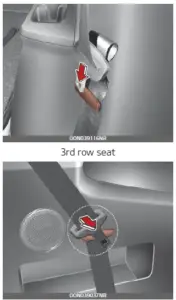
After inserting the seat belt, tighten the belt webbing by pulling it up.
CAUTION
When pulling out to wear the seat belt, the tongue should be slowly pulled out of the seat belt guide so that the seat belt guide does not come off the trim.
WARNING
3rd center seat belt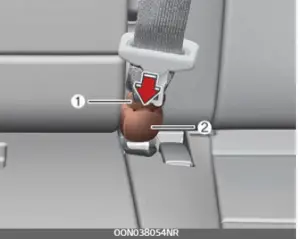
Do not separate the mini tongue (1) and mini buckle (2) even if there is not an occupant.
If it is separated, It may hit the rear seat occupants in a collision or sudden stops.
Releasing the seat belt:
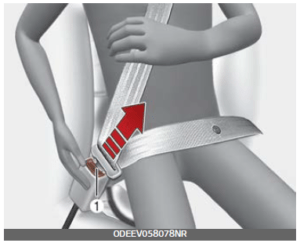
- The seat belt is released by pressing the release button (1) on the locking buckle.
When it is released, the belt should automatically draw back into the retractor.
If this does not happen, check the belt to make sure it is not twisted, then try again.
2023 Kia Telluride Specs, Price, Features and Mileage (Brochure)
Rear centre seat belt (3rd row)
To fasten your seatbelt:
- Extract the tongue plate (A) from the hole on the belt assembly cover.
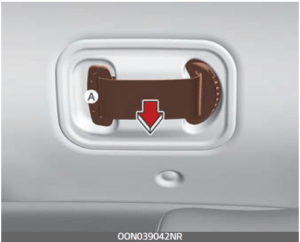
- . Insert the tongue plate (A) into the buckle (A’) until an audible “click” is heard, indicating the latch is locked. Make sure the belt is not twisted.
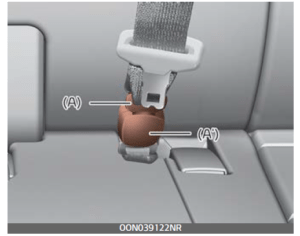
- Pull out the tongue plate (B) from the pocket. Pull the tongue plate
(B) and insert it into the buckle (B’) until an audible “click” is heard, indicating the latch is locked. Make sure the belt is not twisted.

When using the rear center seat belt, the buckle with the “CEN-TER” mark must be used.
NOTICE
If you are not able to pull out the safety belt from the retractor, firmly pull the belt out and release it. After release, you will be able to pull the belt out smoothly.
To release your seatbelt:
- . Press the release button on the buckle (B’) and remove the tongue plate (B).

- To retract the rear center seat belt, insert the tongue plate into the web release hole (A’ ). Pull up on the seat belt web and allow the webbing to retract automatically. Insert the tongue plate (A) into the hole on the belt assembly cover.
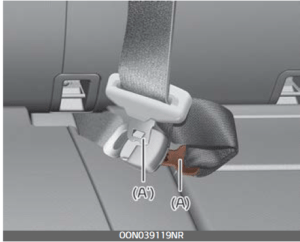
Pre-tensioner seat belt

Your vehicle is equipped with pre-tensioner seat belts at the front outboard seating positions.
The purpose of the pre-tensioner is to make sure that the seat belts fit tightly against the occupant’s body in certain collisions.
The pre-tensioner seat belts may be activated in a collision when the collision is severe enough.
When the vehicle stops suddenly, or if the occupant tries to lean forward too quickly, the seat belt retractor will lock into position. In certain frontal collisions, the pre-tensioner will activate and pull the seat belt into tighter contact against the occupant’s body
If the system senses excessive tension on the driver or passenger’s seat belt when the pre-tensioner activates, the load limiter inside the pre-tensioner will release some of the pressure on the affected seat belt. (if equipped)
WARNING
For your safety, be sure that the belt webbing is not loose or twisted and always sit properly on your seat.
NOTICE
The pre-tensioner may activate not only in a frontal collision but also in a side collision, if the vehicle is equipped with a side or curtain air bag.
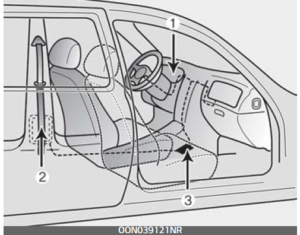 The seat belt pre-tensioner system consists mainly of the following components. Their locations are shown in the illustration:
The seat belt pre-tensioner system consists mainly of the following components. Their locations are shown in the illustration:
- Supplemental Restraint System (SRS) air bag warning light
- Retractor pre-tensioner assembly
- SRS Control Module
WARNING
For optimal usage of pre-tensioner seat belts:
- The seatbelt must be working correctly and adjusted to the proper position. Please read and follow all of the important information and precautions about your vehicle’s occupant safety features including seat belts and airbags that are provided in this manual.
- Be sure you and your passengers always wear seat belts properly.
NOTICE
- When the pre-tensioner seat belts are activated, a loud noise may be heard and fine dust, which may appear to be smoke, may be visible in the passenger compartment. These are normal operating conditions and are not hazardous.
- Although it is harmless, the fine dust may cause skin irritation and should not be breathed for prolonged periods. Wash all exposed skin areas thoroughly after an accident in which the pre-tensioner seat belts were activated.
- Because the sensor that activates the SRS airbag is connected with the pre-tensioner seat belt, the SRS airbag warning light on the instrument panel will illuminate for approximately 6 seconds after the ENGINE START/STOP button has been turned to the “ON” position, and then it should turn off.
CAUTION
If the pre-tensioner seat belt is not working properly, the SRS airbag warning light will illuminate even if there is no malfunction of the SRS airbag. If the SRS airbag warning light does not illuminate when the ENGINE START/STOP button is turned to ON, or if it remains illuminated after illuminating for approximately 6 seconds, or if it illuminates while the vehicle is being driven, have the system inspected by an authorized Kia dealer.
WARNING
- Pre-tensioner seat belt systems are designed to operate only one time. After activation, pre-tensioner seat belts must be replaced. All seat belts, of any type, should always be replaced after they have been worn during a collision.
- The pre-tensioner seat belt assembly mechanisms become hot during activation. Do not touch the pre-tensioner seat belt assemblies for several minutes after they have been activated.
- Do not attempt to inspect or replace the pre-tensioner seat belts yourself. Have the system inspected by an authorized Kia dealer.
- Do not attempt to service or repair the pre-tensioner seat belt system in any manner.
Improper handling of the pre-tensioner seat belt assemblies, and failure to heed the warnings not to strike, modify, inspect, replace, service or repair the pre-tensioner seat belt assemblies may lead to improper operation or inadvertent activation and serious injury. - Always wear seat belts when driving or riding in a motor vehicle.
- If the vehicle or pre-tensioner seat belt must be discarded, contact a professional workshop. Kia recommends visiting an authorized Kia dealer.
- Bodywork on the front area of the vehicle may damage the pre-tensioner seat belt system. Therefore, have the system serviced by an authorized Kia dealer.
Seat belt precautions
Take the following precautions when using seat belts.
Infant or small child
All 50 states have child restraint laws. You should be aware of the specific requirements in your state. Child and/or infant seats must be properly placed and installed in the rear seat. For more information about the use of these restraints, refer to “Child Restraint System (CRS)”
NOTICE
Small children are best protected from injury in an accident when properly restrained in the rear seat by a Child Restraint System that meets the requirements of the Federal Motor Vehicle Safety Standards (FMVSS). Before buying any Child Restraint System, make sure that it has a label certifying that it meets Federal Motor Vehicle Safety Standard 213. The restraint must be appropriate for your child’s height and weight. Check the label on the child restraint for this information. Refer to “Child Restraint System (CRS)”
Larger children
Children who are too large for Child Restraint System should always occupy the rear seat and use the available lap/shoulder belts. The lap portion should be fastened and snug on the hips as low as possible. Check periodically to ensure that the belt fits. A child’s squirming could put the belt out of position. Children are given the most safety in the event of an accident when they are restrained by a proper restraint system in the rear seat. If a larger child (over age 13) must be seated in the front seat, the child should be securely restrained by the available lap/shoulder belt and the seat should be placed in the rearmost position. Children age 13 and under should be restrained securely in the rear seat. NEVER place a child age 13 and under in the front seat. NEVER place a rear-facing child seat in the front seat of a vehicle.
If the shoulder belt portion slightly touches the child’s neck or face, try placing the child closer to the center of the vehicle. If the shoulder belt still touches their face or neck they need to be returned to a Child Restraint System.
WARNING
Small children
Do not allow small children to ride in the vehicle without an appropriate Child Restraint System. If the shoulder belt comes in contact with your child’s neck or face your child is too small to ride in the vehicle. In a crash, the seat belt will inflict injury to your child’s neck, throat and face.
Restraint of pregnant women
Pregnant women should wear lap/shoulder belt assemblies whenever possible according to specific recommendations by their doctors. The lap portion of the belt should be worn AS SECURELY AND LOW AS POSSIBLE.
WARNING
Pregnant women
Pregnant women must never place the lap portion of the seat belt above or on the abdomen where the fetus is located. The force of the seat belt during a collision will crush the fetus.
Injured person
A seat belt should be used when an injured person is being transported. When this is necessary, you should consult a physician for recommendations.
One person per belt
Two people (including children) should never attempt to use a single seat belt. This could increase the severity of injuries in case of an accident.
Do not lie down
To reduce the chance of injuries in the event of an accident and to achieve maximum effectiveness of the restraint system, all passengers should be sitting up and the front and rear seats should be in an upright position when the vehicle is moving. A seat belt cannot provide proper protection if the person is lying down in the rear seat or if the front and rear seats are in a reclined position.
Care of seat belts
Seat belt systems should never be disassembled or modified. In addition, care should be taken to assure that seat belts and belt hardware are not damaged by seat hinges, doors or other abuse.
WARNING
Pinched seat belt
Make sure that the webbing and/or buckle do not get caught or pinched in the rear seat when returning the rear seat back to its upright position. A caught or pinched webbing/buckle may become damaged and could fail during a collision or sudden stop.
WARNING
Seatbelts can become hot in a vehicle that has been closed up in sunny weather. They could burn infants and children.
Periodic inspection
All seat belts should be inspected periodically for wear or damage of any kind. Any damaged parts should be replaced as soon as possible.
Keep belts clean and dry Seat belts should be kept clean and dry. If belts become dirty, they can be cleaned by using a mild soap solution and warm water. Bleach, dye, strong detergents or abrasives should not be used because they may damage and weaken the fabric.
When to replace seat belts
The entire in-use seat belt assembly or assemblies should be replaced if the vehicle has been involved in an accident. This should be done even if no damage is visible. Additional questions concerning seat belt operation should be directed to an authorized Kia dealer.
FAQ
A: Safety precautions are essential to protect both the driver and passengers in case of accidents or emergencies.
A: The 2022 Kia Telluride typically seats up to eight passengers in three rows of seating.
A: Yes, seat belts are mandatory for all passengers in the Telluride to ensure their safety in the event of a collision.
A: Seat belts are designed to restrain passengers in their seats during sudden stops or collisions, preventing them from being thrown forward.
A: Yes, the Telluride typically has LATCH (Lower Anchors and Tethers for Children) anchors to secure child safety seats.
A: Refer to the vehicle’s owner’s manual and the child safety seat manufacturer’s instructions for guidance on proper installation.
A: Some Telluride models may offer rear-seat entertainment systems, which can be a helpful feature for keeping passengers entertained.
A: Yes, many Telluride models are equipped with a rearview camera to aid in parking and backing up.
A: Yes, the Telluride often comes with advanced safety features such as lane-keeping assist and adaptive cruise control to enhance safety during highway driving.
A: If the airbag warning light comes on, it’s essential to have the vehicle inspected by a qualified technician to diagnose and address any issues.
A: Yes, the Telluride typically includes side-impact airbags in addition to front airbags for enhanced safety.
A: Some Telluride models may have the option to deactivate the passenger-side airbag when using a child safety seat.
A: Seat belts should be inspected regularly for signs of wear or damage, and they should be replaced if any issues are detected.
A: Some Telluride models may offer features like automatic crash notification, which can alert emergency services in the event of a collision.
A: If you have any safety concerns or questions about seat belts, it’s advisable to contact your local Kia dealership or refer to the vehicle’s owner’s manual for guidance and assistance.
Useful Link
View Full User Guide: Kia Telluride 2022 User Guide
Download Manuals: https://owners.kia.com/content/owners/en/manuals.html
2023 Kia Telluride Specs, Price, Features, Milage (brochure)

